How Do I Choose What Pier Is Best for My Foundation?

This article is simply an approach that will allow you to discover and understand what is underneath your dwelling. The goal of this article is not to help you design office buildings, and nothing will replace the calculations done by an architect or a design office.
How Do I Choose What Pier Is Best for My Foundation?
There are generally several types of footings for foundations: the stepped footings (for sloping ground) and the insulated footings (which is placed on a point, for example under a pole). The stepped footings type of foundations is carried out on specific soils, e.g. on unstable soils, on rocky soils or when additional land has been added to existing land. A reinforced concrete slab must also, therefore, be very thick to be stable and the ground on which it will be laid, and as homogeneous as possible.
Commonly used in building construction, footings can be made of reinforced concrete or not. You should ensure that your concrete is uniformly cast, and covers all of your foundations. Note that the diameter and dimensions of your reinforcement will depend exclusively on the results of the geotechnical study and the plan of your dwelling.
It should be noted that the foundation trench of an individual house must be at least 23 inches deep and at least 20 inches wide. Finally, arrange frames at the locations of future posts. In practice, the idea will be to place studs at the corners of the containers, in other words where the structure needs to be supported by the foundations. To make foundations, the concrete must imperatively be cast at a single time. Your concrete must cover all your frames.
Armature
Your armature must not be in contact with the ground. Then place the foundation frames directly into the trenches, bonding them using bonding frames. Begin by placing wooden holds, every two meters, at the bottom of your trench.
There are several possibilities for future owners, and they will be able to turn to concrete foundations that are the most classic. Once the concrete is poured, level it over the entire surface. This will allow you to connect the foundations of a house to the rest of the building.
If you want to know the answer to the query: “How do I choose what pier is best for my foundation?” Well, restoration professionals usually depend on helical piers. It should also be noted that concrete-block foundations are ideal for wet or flood-prone areas.
This means that metal frames must be installed on the foundations. You will begin to pour the concrete at one of the corners of the trench, then spread it out immediately to prevent it from drying out. Take care to tie all the frames together with wire, so that they do not become loose when you cast the concrete.
It is impossible to know the size of the foundation trenches without conducting a soil survey. In addition to being self-supporting, some homes are simple and fast to build, with foundations that are not synonymous with large jobs.
